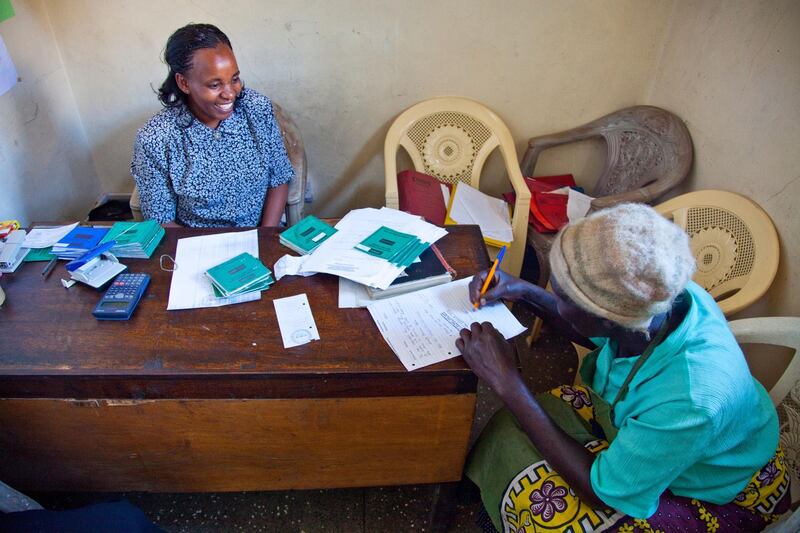Micro-lending has long been touted as a pathway out of poverty, but evidence is growing that for many of the world’s poor, it leads nowhere but into a debt trap.
The concept of making small loans available to the poor is almost 40 years old. Its origins are usually traced back to Bangladeshi economist Muhammad Yunus, who in the early 1980s started his Grameen bank to provide loans to local seamstresses.
Mr Yunus' initial success with Grameen led to him promoting the concept around the world, which eventually earned him the Nobel Prize for his project in 2006. By 2016 micro-lending had grown to a $102 billion a year enterprise worldwide, according to Convergence, an EU-backed research organisation.
As it has grown, so have warnings that it can also lead the most vulnerable into debt they cannot hope to repay.
“When people in the US had access to credit cards beginning in the 1960s, did that pull millions of people out of poverty?” asks Bruce Wydick, Development Economist at the University of San Francisco, who questions the lofty predictions that micro-loans can end poverty. The answer to his question, he says, is a resounding "no”.
It is not to say that providing capital to people in the lowest economic rungs cannot deliver positive results. As with formal banking loans however, the capital allocated needs to be targeted at those most likely to put it to productive use. Formal banks often put loan applicants through a thorough vetting process. Micro-lending needs to do the same if it is to generate the benefits it claims it does, Mr Wydick says.
“If we can target it at highly aspirational, experienced entrepreneurs, we are probably likely to get a bigger bang for the buck out of it.”
Recently, an alarming report in Kenya points to how micro-lending is building towards a consumer debt crisis in the country. Kenya charity Financial Sector Deepening, together with the country’s central bank, found that one in five Kenyans has defaulted on a loan, as they wallow in debt. Much of the spending was on consumer goods or online gambling rather than investing in an enterprise.
“The percentage of Kenyans borrowing from any source has now reached 50 per cent of the population,” says Tamara Cook, CEO of FSD. While not entirely bad - lack of credit holds back families that cannot access capital - it also has to be matched appropriately with the borrowers need, she notes.
“It’s most productive when it helps with productive growth, for example helping a family grow a business, or for education.”
Kenya has the perfect storm of a well-established mobile banking network, where consumers use their handsets to control their money. Micro-lenders are now making loans available on request, allowing borrowers to access up to $500 unsecured, and spend it how they like.
Consumers report that the apps that they use to access loans also aggressively use pop-ups to remind late payers they are falling behind in their loans. Some also claim interest rates as high as 300 per cent on borrowed money. When they do fall behind, other apps will offer more loans.
The unchecked growth is in part a result of the glowing reports and powerful backers of micro-loans, which tout the benefits to entrepreneurs and SMEs. These include the World Bank, the G20, USAID, the Bill & Melinda Gates Foundation and other major international institutions, says Nicholas Loubere, a lecturer at Lunde University in Sweden. These institutions believe that micro-lenders will promote development and alleviate poverty in the Global South.
Mr Loubere has emerged as a leading sceptic around the reported benefits of micro-lending. He points to a study published a couple of years ago, that claims Kenyan mobile money system M-Pesa increased per capita consumption levels and lifted 194,000 households, or 2 per cent of Kenyan households, out of poverty. This study is now routinely quoted in publications, with few questioning its veracity.
“Once something becomes a 'scientific fact' in this way it is very difficult to advance a counter-narrative, as the associations have already been made in the popular imagination,” he says. “This is compounded by the fact that mainstream media outlets generally do not seem interested in following up on critiques of the development 'miracles' they help manufacture.”
Mr Loubere believes that studies such as these are flimsy and cherry pick data that focuses on middle class households, rather than digging down to how the poor are managing their debts.
It does appear that in some countries at least, doubt at the government level is emerging on the value of encouraging mass borrowing. In 2016, the central Bank of Ghana (BoG) began to revoke the licences of dozens of micro-lenders after then president John Mahama called them "pyramid schemes".
By mid-2019, the BoG had nearly 350 micro-lenders listed as insolvent, and it continues to pull licences when it suspects micro-financiers are under-capitalised or represent a financial threat to consumers. In July and August this year alone, another 23 banking permits were suspended, and the government says it is now planning sector-wide reforms. These will include a public education campaign and an internal ‘ratings agency’ to provide Ghanaians insight into the financial health of micro-lenders.
“We hope to strengthen regulations around micro finance and mobile loans,” Sampson Akligoh, a senior official in the Finance Ministry of Ghana told state television. “This way, we intend to promote financial inclusion.”
South Africa, the largest industrial economy on the continent, has taken a different approach. In August the government passed a ‘credit relief’ bill, aimed largely at consumers who build up micro-loan debt they cannot pay. It allows borrowers with up to 50,000 rand in debt to have their loans suspended for up to 24 months.
South Africa was one of the pioneers of micro-loans in Africa, and most large banks have a micro-lending unit. Unlike Kenya or Nigeria where micro-lenders usually offer unsecured loans, South African institutions normally require borrowers to have a formal bank account and a fixed income such as a salary. This way, debit orders for interest and loan repayments can be automatically deducted. For those who fall into arrears, their entire wage can be docked the day it lands in their account.
South Africans have consequently run up so much debt that there are almost as many people classified as ‘impaired’ or in default, as there are creditors in good standing. According to the National Credit Bureau, just under 10 million people have bad loans to their names, with just over 10 million consumers still able to get easy credit.
The credit relief bill is intended to reduce the growing number of debt-stressed South Africans, but has encountered widespread objections from economists, micro-lenders and banks. Industry experts warn of potentially big losses for lenders as well as fewer loans being issued. Banks lobbied hard against the bill, even proposing a voluntary debt relief programme of their own.
“South Africa’s banking industry has previously raised concerns with the bill after it proposed writing off around 25 billion worth of debt,” says Chiedza Madzima, Head of Operational Risk at Fitch Solutions in Johannesburg. “This has big implications for banks and retail.”
Ultimately, selling micro loans as a pathway out of poverty may only send more people into a debt trap. The need is for governments to educate themselves and consumers on the downfalls of borrowing, says Mr Loubere of Lund University.
“Rather than being lauded as the new panacea for development and poverty reduction, digital-financial inclusion initiatives like M-Pesa should, therefore, be rigorously scrutinised,” he said. “If this does not happen, we can look forward to two more decades of failed development policy with hugely negative outcomes for poor households around the world.”







